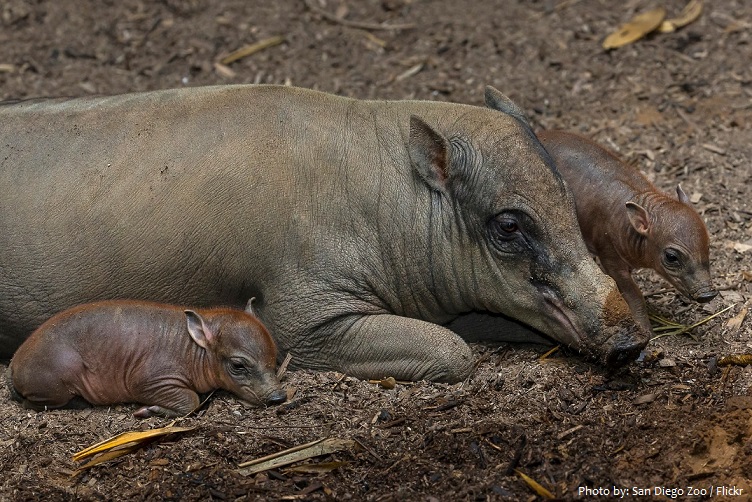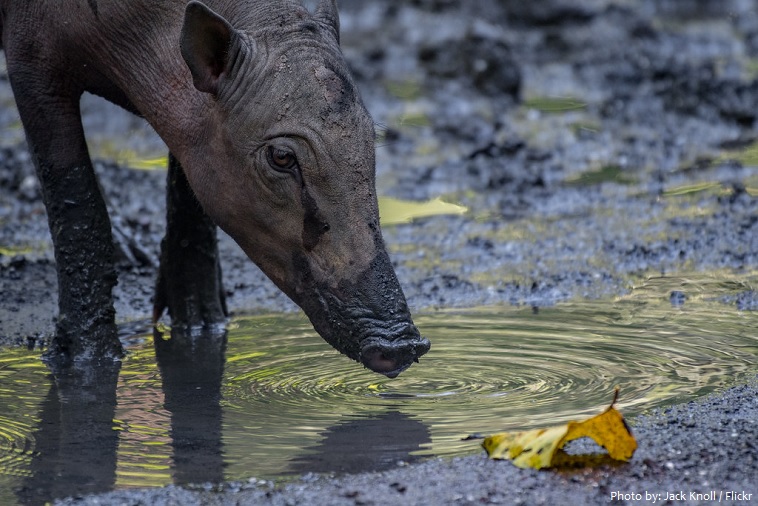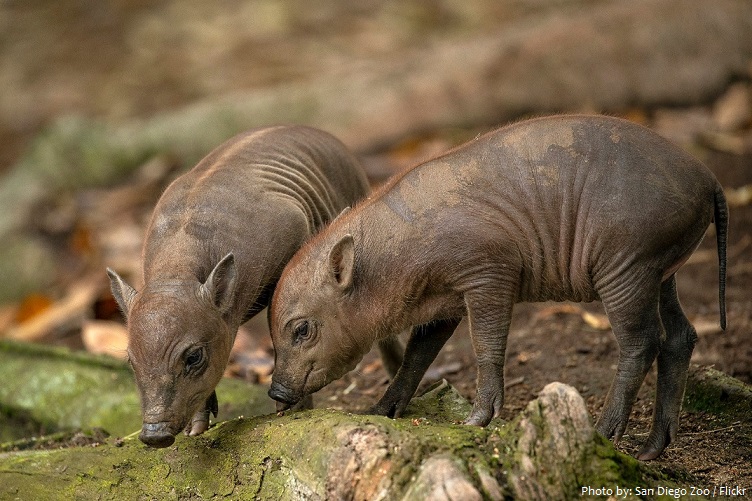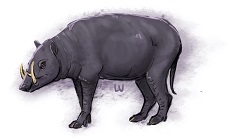
The babirusas, also called deer-pigs are wild pigs.
Babyrousa is a genus – all members of this genus were considered part of a single species until 2002, when was split into several species.
The remarkable “prehistoric” appearance of these mammals is largely due to the prominent upwards incurving canine tusks of the males, which actually pierce the flesh in the snout.
Babirusas are found in Wallacea, or specifically the Indonesian islands of Sulawesi, Togian, Sula and Buru.

The stout-bodied, short-tailed babirusa stands 65–80 cm (25–30 inches) at the shoulder and can weigh over 90 kilograms (200 pounds).
It has a rough, grayish hide and is almost hairless.
Its most notable feature is the exaggerated development of the upper and lower canine teeth, or tusks, of the male. Those of the upper jaw grow upward from their bases so that they pierce the skin of the muzzle and curve backward, eventually almost touching the forehead. The tusks can reach up to 30 cm (2 inches).

What are those tusks for remains a mystery. An early hypothesis was that the males use their tusks during fights over females. Or perhaps the tusks serve as protection of the face and eyes from the slashing lower tusks during an altercation. It seems reasonable, until a babirusa tussle is observed. Instead of tangling up their tusks, the animals rise up on their hind legs and “box” each other with their front hooves. Unlike elephant tusks, babirusa tusks aren’t built to withstand much pressure – they are fragile and not well suited for combat.
The babirusa is a docile, retiring, night-hunting animal of dense jungle.
It is a fast runner and swims readily.
When foraging, it roots in soft soil near rivers and in swamps.

Babirusas will eat almost everything. These omnivorous pigs consume leaves, fruits, berries, nuts, mushrooms, bark, insects, fish, and small mammals (even smaller babirusas!). They use their specialized hooves to dig for insect larvae and roots in the ground and can also stand on their two
hind legs and forage on leaves high in the trees—very similar to a gerenuk in Africa.
Male babirusas tend to live in solitary or in bachelor herds of two to three males, while females can be found in groups of up to eight individuals with young. They spend the majority of the day roaming and foraging throughout the forest. Little is known about this shy, forest-dwelling pig’s habits in the wild. Based on observation of captive animals, the babirusa appears to be mostly diurnal—active during the day and sleeping at night. When not foraging, they may wallow in the mud or just lie down and rest during the heat of the day.

Mating season occurs from January to August – fights between rival males precede mating. Gestation in females lasts 155 to 158 days and ends with one or two piglets (which is a small litter for pigs) and they lack stripes on their skin. This reduced litter size and lack of camouflage is often attributed
to the babirusa’s predator-free environment. Piglets nurse for the first six to eight months of life. They typically begin to explore their environment and enrich their diet with solid food at about 10 days old. The piglets develop quickly.
The wild population of babirusas is estimated to be less than 10,000.
All extant species of babirusa are listed as vulnerable or endangered by the IUCN.

Babirusas are protected in Indonesia and killing them is illegal in most cases. However, poaching remains a significant threat to the babirusa. Additionally, commercial logging operations threaten the babirusa by habitat loss, and also reduce cover, making the babirusa more exposed to poachers.
Babirusa means “pig deer” in the language of Malay – their tusks resemble deer antlers.
In Indonesia, the striking appearance of the babirusa has inspired demonic masks, and the animal itself is sometimes used as a gift to present to visitors.
The Balinese Hindu-era Court of Justice pavilion and the “floating pavilion” of Klungkung palace ruins are notable for painted babirusa raksasa (grotesques) on the ceilings.
Prehistoric paintings of babirusa found in caves on the island of Sulawesi in Indonesia have been dated back at least 35,400 years (to the ice age Pleistocene epoch). Adam Brumm, who co-authored the 2014 study dating the paintings, said “The paintings of the wild animals are most fascinating because it is clear they were of particular interest to the artists themselves.
